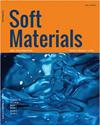Structure and dynamics in active matter systems
IF 1.4
4区 材料科学
Q4 MATERIALS SCIENCE, MULTIDISCIPLINARY
引用次数: 0
Abstract
Active matter systems are made of self-propelling particles and make ideal ground for studies of out-ofequilibrium phenomena. The self-propulsion is fueled by continuous drawing of energy from the environment at the single-particle scale. Examples of such systems are common, covering a wide range of lengths, from molecular level biological systems to large societies of animals. It is, however, not necessary that the constituents should only be living objects. These systems often exhibit fascinating patterns and dynamics. Understanding such collective phenomena is of importance from fundamental as well as practical points of view. Despite conceptual difficulties, [4–7] e.g., with respect to the definition of temperature, significant advancement has been made at the theoretical level. In the domain of nonequilibrium statistical mechanics, there exist simple models that are helpful in capturing interesting experimental facts. A primary interest in the area of active matter is in the understanding of fundamental aspects of nonequilibrium-phase transitions. Studies along this direction are motivated by observations of structures and dynamics in assemblies like a colony of bacteria or a flock of birds, [1,27] resembling those concerning phase transitions in passive matter systems. Model dynamical systems having Vicsek-like simple velocity alignment rules or possessing active Brownian particles (ABP) as constituents have been useful in realizing many of the observed structural and dynamical features spanning wide scales of length and time. In the passive case anomalous behavior of various thermodynamic and transport properties, [28,38,42,44] upon approach of the state point toward the criticality, have been quantified experimentally and are captured by combinations of analytical theories and computer simulations. A major drive in this area has been in the understanding of universality in the exponents of power-law singularities. Analogous questions have been asked in the context of kinetics of phase transitions as well. In this area, following quench of a homogeneous system, inside the coexistence region, as the new equilibrium is approached, investigations have focused on learning universality in the evolution dynamics. There the primary interest has been in the exponent for the power-law time dependence of average size of domains that are either rich or poor in constituents of a specific type. Among other interests in this sub-branch two important ones are in understanding scaling properties associated with pattern and aging in the coarsening systems. Both critical and coarsening phenomena are of importance in the active matter context as well and have been receiving attention. In critical phenomena there exist debates on universality. Unlike for the passive systems here the universality may be weak and different types of transport, e.g., presence or absence of hydrodynamic interactions, [40,45] may change critical properties that will remain unaltered in the passive case. Coarsening phenomena in this category of systems started getting systematic attention only recently. Apart from the aspects related to phase transitions, it is important to understand structural and dynamical properties, under varying environmental conditions, even in the normal regions of the phase diagrams, in the steady state situations. This special issue contains theoretical articles that address problems belonging to both the categories, by exploiting state-of-the-art analytical and computational techniques. In addition to being of fundamental nature, several of the contributions have strong practical importance. The “perspective” article by Binder and Virnau provides a good discussion on phase transitions and universality. These authors introduce critical phenomena, as well as kinetics of phase transitions, from modern活性物质系统的结构与动力学
活性物质系统是由自推进粒子组成的,为研究非平衡现象提供了理想的基础。这种自我推进是通过不断地从单粒子尺度的环境中汲取能量来提供燃料的。这种系统的例子很常见,覆盖范围很广,从分子水平的生物系统到大型动物社会。然而,这些成分不一定只能是有生命的物体。这些系统经常表现出迷人的模式和动态。从基础和实践的角度来看,理解这种集体现象都很重要。尽管存在概念上的困难[4-7],例如,关于温度的定义,在理论层面上已经取得了重大进展。在非平衡统计力学领域,存在一些简单的模型,有助于捕捉有趣的实验事实。在活性物质领域的主要兴趣在于理解非平衡相变的基本方面。沿着这一方向的研究是由对细菌群体或鸟群等群体的结构和动力学观察所激发的,[1,27]类似于对被动物质系统相变的研究。具有类似维塞克的简单速度对准规则或具有活性布朗粒子(ABP)作为组成部分的模型动力系统在实现许多已观察到的跨越大尺度长度和时间的结构和动力学特征方面是有用的。在被动情况下,各种热力学和输运性质的异常行为,[28,38,42,44]在接近临界状态点时,已经通过实验量化,并通过分析理论和计算机模拟的结合来捕获。这个领域的一个主要推动力是对幂律奇点指数的普适性的理解。在相变动力学中也提出了类似的问题。在这一领域,随着同质系统的猝灭,在共存区域内,随着新的平衡的接近,研究的重点是学习进化动力学中的普遍性。在那里,主要的兴趣是指数的幂律时间依赖于域的平均大小,这些域在特定类型的成分中要么丰富,要么贫乏。在这个分支的其他兴趣中,两个重要的是理解与粗化系统中模式和老化相关的尺度特性。临界现象和粗化现象在活性物质环境中也很重要,并一直受到人们的关注。在批判现象中存在着关于普遍性的争论。与被动系统不同的是,这里的普遍性可能很弱,不同类型的输运,例如存在或不存在流体动力相互作用[40,45],可能会改变被动情况下保持不变的关键性质。这类系统中的粗化现象直到最近才开始得到系统的关注。除了与相变有关的方面之外,重要的是要了解在不同环境条件下,甚至在相图的正常区域,在稳态情况下的结构和动力学特性。这个特刊包含理论文章,通过利用最先进的分析和计算技术,解决属于这两个类别的问题。除了具有基本性质外,其中一些贡献具有很强的实际重要性。Binder和Virnau的“透视”文章对相变和普适性进行了很好的讨论。这些作者介绍了关键现象,以及动力学的相变,从现代
本文章由计算机程序翻译,如有差异,请以英文原文为准。
求助全文
约1分钟内获得全文
求助全文
来源期刊

Soft Materials
工程技术-材料科学:综合
CiteScore
2.90
自引率
0.00%
发文量
21
审稿时长
2.2 months
期刊介绍:
Providing a common forum for all soft matter scientists, Soft Materials covers theory, simulation, and experimental research in this rapidly expanding and interdisciplinary field. As soft materials are often at the heart of modern technologies, soft matter science has implications and applications in many areas ranging from biology to engineering.
Unlike many journals which focus primarily on individual classes of materials or particular applications, Soft Materials draw on all physical, chemical, materials science, and biological aspects of soft matter. Featured topics include polymers, biomacromolecules, colloids, membranes, Langmuir-Blodgett films, liquid crystals, granular matter, soft interfaces, complex fluids, surfactants, gels, nanomaterials, self-organization, supramolecular science, molecular recognition, soft glasses, amphiphiles, foams, and active matter.
Truly international in scope, Soft Materials contains original research, invited reviews, in-depth technical tutorials, and book reviews.
 求助内容:
求助内容: 应助结果提醒方式:
应助结果提醒方式:


